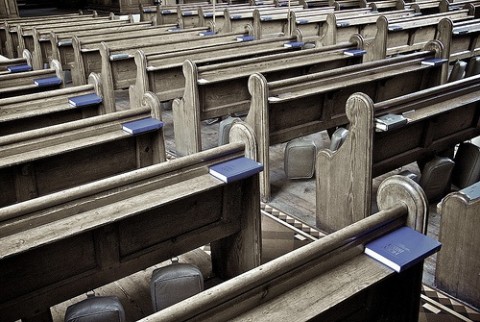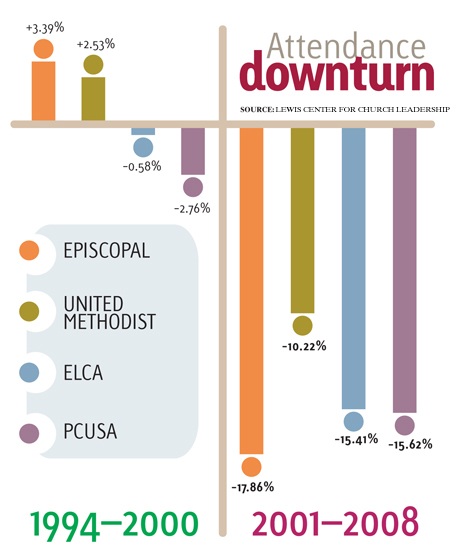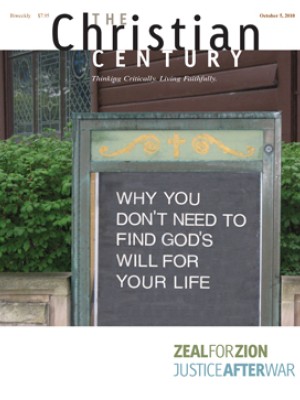No shows: The decline in worship attendance

Many people assume that there has been a steady decline in worship attendance for all the mainline denominations since the mid-1960s—the era when most of them began to see their memberships decline. But trends in attendance—usually thought to be a better indicator of church vitality than trends in membership—have actually followed their own patterns.
For example, the Episcopal Church reported higher attendance in 2000 than in any year since 1991, the year the denomination began recording attendance figures. The United Methodist Church reported worship attendance figures in 2000 that were higher than those in the mid-1980s. The Evangelical Lutheran Church in America had relatively flat attendance rates in the years before 2001, and the Presbyterian Church (U.S.A.) in the 1990s had several years showing modest gains in attendance.
Read our latest issue or browse back issues.
But the years following 2001 have shown a deep recession in worship attendance (see graph below). The losses in worshipers year after year were more dramatic than what data from the previous decade would have predicted.

David A. Roozen, reporting on the findings of the 2008 Faith Communities Today survey of American congregations of all types, points out that the "erosion of vitality" holds not only for "oldline" Protestants but also for evangelical Protestants, Catholics, Orthodox and "other world religions." The new century has brought a "retreat for America's congregations," according to Roozen.
One feature of the recent downturn in attendance is the changing pattern in large churches. In the United Methodist Church, large churches (those averaging 350 or more in attendance) showed steady attendance growth during the 1980s and significant growth during the 1990s, reaching a high point in 2001. Their decline in attendance began in 2002 and has continued every year since. If the large churches had held their attendance numbers at previous levels, there would still have been de-nominational decline, but much less. In essence, the smaller churches continued and somewhat accelerated their decades-long decline while the large churches for the first time joined the decline.
There is one exception to the trend: churches averaging 1,000 or more in worship are still showing growth in most years, with 2008 marking their largest attendance figures ever. For the past four years, the only tier of United Methodist churches in which at least half of the churches showed an attendance increase is the group of churches averaging 1,000 or more in worship during the previous year.
No one knows the reason for the overall attendance drop, but three possible explanations are:
Worshipers attend less frequently. In addition to tracking weekly attendance numbers, some churches are tracking who actually worships during a month. Many pastors sense that the same individuals are worshiping throughout the year, but that they worship less often.
This impression gets some confirmation from the General Social Survey 2008 conducted by the National Opinion Center. It traced according to frequency the percentage of the adult population who attend worship. While the percentage of people who report attending church more than once a week has stayed steady over the years, the percentage saying they attend once a week has steadily gone down. Some pastors have observed that many members of their congregation identify themselves as regular churchgoers even though they may attend only twice a month or less. In earlier times, being a regular churchgoer meant coming to worship almost every Sunday.
Aging constituencies. Mainline churches have a disproportionate number of members age 65 and older. This proportion will only grow more pronounced as the first of the baby boomers reach 65 in 2011. While it does not appear that death rates are changing dramatically in the mainline churches from year to year, many older members may not be attending as often—for health or other reasons.
The other side of this dilemma is the failure of churches to reach younger persons. This is particularly true for the smaller churches that constitute a large part of mainline denominations.
Lack of interest in religion. Adding to the challenge of reaching younger people is the fact that the age group in which self-identified adherents of "no religion" are found most is 25-34. Additional indicators of decreasing interest in church life are found in the General Social Survey 2008: fewer people report going to church "several times a year" and more people report going "once a year." Fewer report going "less than once a year" while many more report going "never." In fact, the attendance category that has grown the most since 1990 is "never."
Church attendance patterns are subject to greater fluctuation, at least in the short term, than membership figures. The relatively strong attendance of the 1990s did not carry over through the next decade. A renewed interest by denominations in reaching beyond traditional racial and class constituencies and in reaching younger people may lead to an increase in worshipers. But it's also possible that these denominations are approaching a tipping point: with fewer and increasingly older members, the shrinking attendance will make many congregations unsustainable. In the 21st century mainline churches will face perhaps their greatest challenge since they faced the American frontier of the 19th century.






